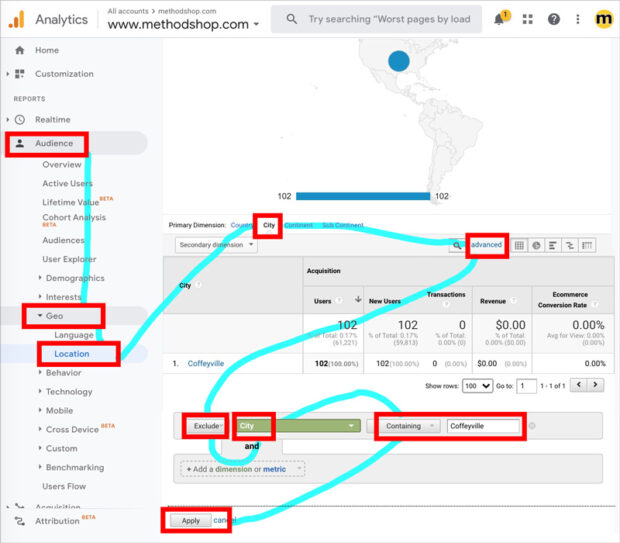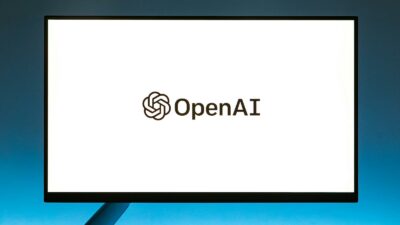Table of Contents[Hide][Show]
- Location Privacy Is A Growing Concern With Internet Users
- Coffeyville Kansas Is The Center Of The United States… According To Google Maps
- Why Am I Seeing So Much Web Traffic From Coffeyville Kansas In Google Analytics?
- The Impact Of The Kansas Problem On Digital Advertising Campaigns
- Use Advertising Products With Better Targeting Capabilities:
- Don’t Panic About The Coffeyville Google Analytics Problem
Have you noticed an increase lately in web traffic from Kansas? Us too, and it keeps growing year after year. Specifically, an unusually large amount of traffic is coming from a small city in Kansas called Coffeyville. The issue, nicknamed The Kansas Problem, is actually a bug in how Google resolves unknown user locations. Here’s everything that you need to know about the Kansas Problem and how to fix it.
Location Privacy Is A Growing Concern With Internet Users
From a consumer perspective, it’s starting to feel like our privacy is under attack. Advertisers use various technologies, including addressable advertising, search history retargeting, GeoFencing, and even GeoCookies (mobile phones’ historical location) to target consumers with ads. Databases that include your credit card purchase history, GPS coordinates of what stores you shop at, and what websites you search for and visit are all being used to deliver targeted ads.
As a result, consumers use VPNs, use ad-blocking web browsers like Brave, and spend more time adjusting their privacy settings on their digital devices. Hiding your location online creates a problem for a reporting perspective, which leads us to why Coffeyville, Kansas, is such a prevalent location in your analytics.
Coffeyville Kansas Is The Center Of The United States… According To Google Maps
If your exact location can’t be determined due to your privacy settings, Google does the next big thing and assigns your data to a region. Google knows that your device is located somewhere within the United States; it just doesn’t know where. So Google Maps will assign your data to the default location for the United States. Can you guess where that might be? That’s right, Coffeyville, Kansas.
If you look closely at a map of the United States, the approximate geographic center of the country is the city of Coffeyville. This small city near the south-east corner of the Kansas state line has a population of less than 10,000! More people search for the Coffeyville “Kansas Problem” online every month than live there.
So instead of listing those user locations as “Unknown,” Google Analytics instead assigns them to Coffeyville. That doesn’t mean that the users in your reports were ever near Coffeyville.
NERD NOTE: Google didn’t develop Google Analytics. In 2005, Google acquired a company called Urchin Software Corporation and its popular Urchin On Demand analytics product, which cost users $199 per month. Google relaunched Urchin On Demand as Google Analytics a year later with a new price, free. Years after the acquisition, several elements of Urchin’s platform remain a part of Google Analytics. For example, today, all advertising campaigns still use UTM parameters in their links that identify important tracking data, including advertising partner, medium, and campaign name. UTM is an acronym for Urchin Traffic Monitor.
Why Am I Seeing So Much Web Traffic From Coffeyville Kansas In Google Analytics?
So the next time someone in your company looks at your Google Analytics and asks you why your website is so popular in Coffeyville, Kansas, send them this article explaining the Kansas Problem.
Rest assured that your website is probably NOT actually popular in Coffeyville, Kansas. However, your website is popular with people who are savvy enough to turn on their location privacy settings. And if your website caters to smart and technically sophisticated users, then that’s a good thing. Unfortunately, you just don’t know where those people live.
The Impact Of The Kansas Problem On Digital Advertising Campaigns
It’s one thing to see Coffeyville as a top location in your website’s organic traffic. But if you are running digital advertising campaigns, how do you explain the Kansas Problem to your clients?
I’ve encountered the Coffeyville Google Analytics problem more than a few times when managing digital ad campaigns for advertisers. The target locations for their campaign will often be nowhere near Kansas, but Coffeyville will usually appear among the top cities in every campaign.
Unfortunately, many advertisers get angry and think that they are being cheated or that someone made a geo-targeting mistake. Depending on the advertiser, explaining the “Kansas Problem” to them might make things worse. I’ve seen some advertisers lose faith in digital advertising after learning about the Kansas Problem and move their budgets back to broadcast.
How Do You Fix This Coffeyville Google Analytics Bug?
Now what? We’ve identified the issue. How can we fix the Kansas Problem? Unfortunately, you can’t “fix” Google. Your only options are these workarounds.
Interpreting Your Google Analytics Reports:
If you see Coffeyville or Unknown as a top location in your Google Analytics reports, proportionally move that traffic to your other top locations. For example, if I see 1,000 page views from Coffeyville in my top 10 locations report, I’ll remove Coffeyville, promote the 11th location to the top 10 and add 100 to each city.
Filtering Out Coffeyville From Google Analytics:

If you need to build reports for your clients or leadership team, then you can create a filter in Google Analytics to remove Coffeyville Kansas traffic.
- Open Google Analytics
- Go to Audience > Geo > Location
- Select City under Primary Dimension
- Click on Advanced
- Select Exclude from the drop down menu
- Select City as your dimension
- Select Containing from the drop down menu
- Type Coffeyville into the field
- Click on the Apply button
- That’s it. All Coffeyville metrics are now removed
Use Advertising Products With Better Targeting Capabilities:
The Kansas Problem is mostly associated with awareness-based display and video ads. If geo-targeting is very important to your clients, then try using advertising products with better location control like geofencing, SEM, and search retargeting display. You’ll have more success working the bottom of the sales funnel anyway vs an awareness display campaign.
Don’t Panic About The Coffeyville Google Analytics Problem
Personally, I think blindly resolving Internet traffic to Coffeyville, Kansas, is a ridiculous solution on Google’s part. Why not just be honest and say that the user’s location was Unknown? Google Analytics already does that with gender. If Google can’t identify the gender of a user, it lists their gender as unknown. Sometimes not knowing the answer is a better answer than a blind guess or estimation.
So if you start seeing large amounts of web traffic from a small Kansas town hundreds of miles away from your geo-target, don’t assume that your site is suddenly popular in Coffeyville or that you’re wasting ad dollars with poor targeting – it could just be The Kansas Problem.
Do you have any tips on how to deal with The Kansas Problem? Please share them in the comments. Thanks.
The Kansas Problem: Why Is Your Website Getting So Much Damn Traffic From Coffeyville, Kansas? Share on X
Frank Wilson is a retired teacher with over 30 years of combined experience in the education, small business technology, and real estate business. He now blogs as a hobby and spends most days tinkering with old computers. Wilson is passionate about tech, enjoys fishing, and loves drinking beer.















 10 Stunning Pieces Of James Bond ASCII Art
10 Stunning Pieces Of James Bond ASCII Art
Leave a Reply
You must be logged in to post a comment.